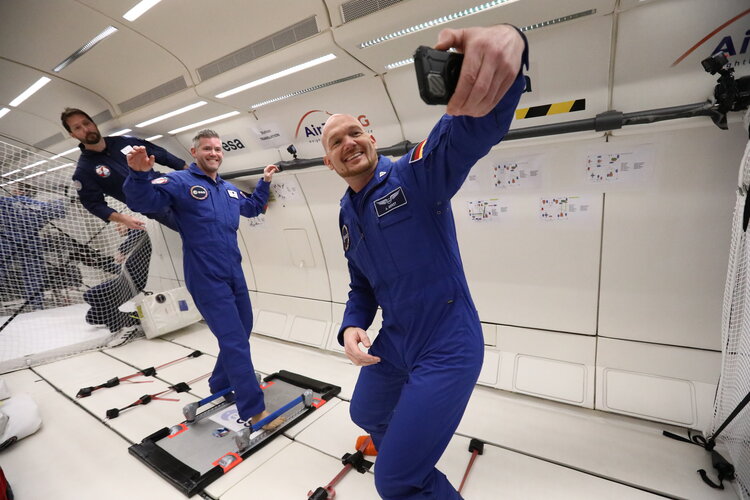ESA Astronaut Reserve member John McFall poses for a picture while his body familiarises itself with the challenges of controlling his movements in 'weightless’ conditions. Flying with him on the Airbus ‘Zero G’ aircraft were experienced European spacewalkers Alexander Gerst and Thomas Pesquet for safety and support.
Over repeated climbs and dives of the plane, parabolic flights recreate a state of weightlessness for 20 seconds at a time. John trained in several working stations on the plane while wearing his prosthetic leg.
The former Paralympic sprinter and orthopaedic surgeon from the UK suffered the amputation of his right leg at age 19 following a motorcycle accident. He practised stabilising himself and performing cardiopulmonary resuscitation techniques, better known as CPR, while being upside down in reduced gravity.
Since 2023, John is a key figure in the pioneering ‘Fly!’ feasibility study that investigates whether it would be possible for a professional astronaut with a physical disability to embark on a mission to the International Space Station, which typically lasts six months.
As an elite athlete with a passion for biomechanics and health science, John brings a diverse background to his role in Fly!
“My experience gives me the ability to take an active role rather than being a passive subject. My skills allow the team to explore potential barriers and come up with solutions to make human spaceflight more inclusive,” explains John.
Hands-on experience is crucial for this study. John has worked with international partners and industries to test equipment and different scenarios and come up with solutions to improve accessibility to space, especially in emergency procedures.
John explains that from a very early stage the team realised that if he had to leave the spacecraft during an emergency on the launch pad, procedures would need to account for his prosthetic leg.
“My leg would need to be compatible to be worn with the spacesuit, inside the capsule and on the International Space Station, where I would need it to exercise and keep myself fit. My prosthesis would need to meet and adapt to all the requirements,” he says.
To this day, Fly! has not identified any showstoppers which would prevent an astronaut with a disability like John's from flying into space.
The Fly! study will conclude in late 2024. ESA continues to push the boundaries of what is possible,ensuring that space exploration is a shared human endeavour.
Follow John’s journey on Instagram and X, and listen to his story with the ESA Explores podcast.



 Image:
Space is not the limit
Image:
Space is not the limit